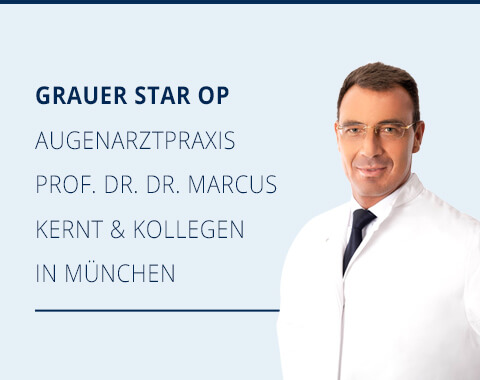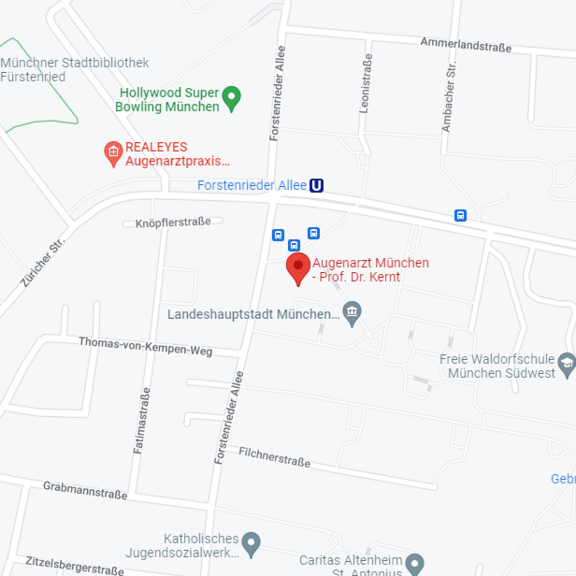Cataract - operation
Fact box
| The right time for surgery: | This is at the discretion of the patient and the doctor, it depends on the individual patient and on the degree to which everyday activities are impaired. |
|---|---|
| Choosing the lenses: | Optional standard lenses or special lenses with additional function |
| Operation: | Outpatient operation with local anaesthetic |
| Duration: | 15 – 20 minutes |
| Follow-up care: | Physical exertion and sauna and swimming pool visits must be avoided for up to 6 weeks after surgery |
| Costs: | The health insurance companies cover the standard lenses; the patient has to cover the difference between standard lenses and special lenses, which is between 100 and 2,500 euros depending on model and time and effort |
Until only a few decades ago, to regain their eyesight cataract patients had to undergo a painful and not entirely safe procedure. This has changed significantly in recent years, because thanks to the surgical procedure used by Prof. Marcus Kernt, where the diseased lens is carefully and gently replaced by an artificial lens, cataract treatments are now pain-free and low-risk. Cataract surgery is now a minimally invasive procedure and one of the most common surgical procedures overall.
Frequently asked questions about the cataract operation
What happens during cataract surgery?
During a short and pain-free procedure, the clouded lens is replaced by an artificial lens.
Do normal standard lenses significantly improve your eyesight?
As a rule, standard lenses ensure that your eyesight is fully restored. However, for perfect vision you may have to be fitted with glasses after the operation. Certain visual defects or strong corneal curvatures cannot always be fully corrected with standard lenses.
How long does it take before I can see again after the surgery?
Usually, the patient’s eyesight improves quickly after surgery and gets better with each passing day. The healing process will be complete and your vision will be as good as it will get after a few weeks.
Can the cataract re-occur?
No, but sometimes the natural lens capsule into which the artificial lens is inserted can become cloudy. This so-called aftercataract can be easily treated with simple laser surgery.
Before the operation
The time of surgery depends on a number of factors and is generally a very personal decision taken by the doctor and the patient together. Because in addition to a number of objective metrics, the decision to undergo surgery ultimately depends on the degree to which you feel affected by the disease day to day and to what extent it affects your quality of life. During a detailed preliminary meeting we discuss the details of all important aspects of the procedure with you. Prof. Marcus Kernt will explain exactly what happens to you, including the individual treatment methods and any associated risks. All your questions will of course be answered. In addition to questions about the surgery itself, choosing the right lens is an important factor, because in some cases it is decisive for your future eyesight and thus your quality of life. Generally speaking, there is not just a good intraocular lens, the lens in question also has to be a perfect match for your eye. Prof. Kernt will therefore talk to you about which type of intraocular lens (IOL) is best for you. As a rule, standard monofocal lenses (which are paid for by the health insurance companies) provide excellent imaging quality and also have a UV light protection filter. However, these single-strength lenses are not always able to fully correct certain visual defects, such as corneal curvatures or what we call presbyopia, or age-related long-sightedness. Special lenses are available for that with an additional function that can eliminate or improve specific visual deficits. Toric intraocular lenses, for example, are better at correcting corneal curvatures (astigmatism), multifocal lenses improve the patient’s vision in some areas and at different distances, and sometimes patients no longer have to wear near vision or far vision glasses. Prof. Kernt will introduce various types of lenses that can be beneficial to you, because not every lens is equally suitable for every patient. However, it is up to you whether ultimately you opt for a standard lens or a special artificial lens.
The operation itself
In most cases you undergo cataract surgery as an outpatient, and there is no need for a hospital stay. The short procedure only takes 15 to 20 minutes, and you can go home soon afterwards. There is no need for a full anaesthetic – a local anaesthetic of the eye is enough to make the procedure completely painless. This local anaesthetic is given in the form of eye drops or an injection next to the eye. Prof. Kernt often recommends conscious sedation, where the patient briefly falls asleep for the duration of the anaesthesia and the surgery. This helps patients who are fearful or nervous about the operation. We consider a general anaesthetic for patients who are very fearful. Usually, the two eye lenses are not clouded to the same degree. As a rule, the eye that is most affected is operated on first. The second operation will be performed a few weeks later, once the vision of the first eye has been restored. Prof. Kernt offers two cataract surgery methods. One is called phacoemulsification, which uses ultrasound technology. This proven and constantly refined method is highly efficient and safe. It is a microsurgical procedure, which means it is performed using a microscope, which transmits the process onto a screen. In a first step, the cornea is opened with a tiny incision of just a few millimetres. The incision will not have to be stitched up or closed in any other way after the operation – after a short while it will heal by itself. Through the incision, the diseased lens is then shattered into tiny fragments, liquefied and sucked out using high-frequency ultrasonic waves. As a rule, the lens capsule on the side and back are fully preserved. The remaining capsule serves as a holder into which the artificial lens is then precisely inserted. The extremely flexible lens is folded such that it can be easily pushed through the small opening in the cornea. Only once it is in the lens capsule it is carefully unfolded and put into place. Tiny integrated brackets (haptic) attach the lens onto the capsule walls and fix it in place. Sometimes the procedure is performed using a computer-assisted femtosecond laser (Femto-Cat-OP). In this case, the high-precision laser automatically performs the operation steps such as opening and shattering the diseased lens. However, this method is not as suitable for advanced clouding, because then the laser beams cannot penetrate the very dense tissue enough. What’s more, the potential benefit compared with the relatively high cost of this technique must be weighed up and discussed for each individual case.
Operation with or without preserving the lens capsule
If possible, the artificial lens should be positioned in the natural place in the eye. In certain cases, (such as in the case of a defective holding apparatus or lens capsule) it may be necessary to deviate from this natural position. This is either called an extracapsular or an intracapsular operation, depending on whether the lens capsule stays intact or not. In most cases, we can perform extracapsular surgery, where the artificial lens is inserted into the preserved capsular sac, which acts as a bracket; in this case the lens is inserted into the same position in the eye as the natural lens as much as possible. The undamaged capsule wall serves as a natural barrier between the lens and the posterior section of the eye. However, it is not always possible for the lens capsule to remain intact. Intracapsular surgery is required when the disease is at an advanced stage or the holding apparatus of the lens is not sufficiently stable. In this case, the lens and lens capsule are removed completely. If the cataract is very advanced, the damaged lens is sometimes removed whole without shattering it first. While this procedure calls for a larger incision, it is more gentle on the cornea.
After surgery
Immediately after the minor operation, we apply a kind of ointment dressing that protects your eye. This can be removed the very next day. The world will already look a little more focused, and from then on your vision will improve with each day. Your vision will have been completely restored after several days. In the first weeks after the surgery, anti-inflammatory and antibiotic eye drops ensure complication-free healing, as do regular check-ups. During this time you should avoid rubbing your eye or pressing on it and make sure no soap gets into the eye. We also recommend that you do not carry out any physically strenuous activities or visit saunas or swimming pools in the weeks after the procedure.
Treating the aftercataract
In most cases, the restored vision will be reserved permanently. In some patients, the posterior wall of the natural lens capsule can cloud a little after a while – this is called an aftercataract. This subsequent clouding can usually be treated quickly and straightforwardly with laser treatment. It does not require surgery – and it does not damage the premium quality artificial lens.
Treatment costs
All statutory health insurance companies currently cover the outpatient cataract operation. However, this only applies to so-called standard lenses. If the patient opts for a customisable premium lens, the patient pays the difference in price to the standard lens. Depending on the type of lens, this can be anything from 100 to 2,500 euros per eye. Generally speaking, measuring the eye using optical biometry does not incur additional costs in our practice (primary refractive surgery is an exception).
Do you need more information about cataracts? Then call us on 089 217 687 02 – we will be happy to help!
Contact
We are happy to advise you!
Prof. Dr. Marcus Kernt
Forstenrieder Allee 59
81476 München






